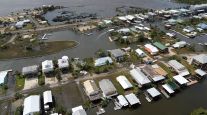Southeast Floods Bedevil Supply Chain; Freight Industry Struggles to Rebound
This story appears in the Oct. 17 print edition of Transport Topics.
Hurricane Matthew’s widespread havoc across the Southeast still was tying the supply chain in knots late last week with flooded roads, delayed deliveries and cargo backed up at terminals.
Truckers initially faced hundreds of miles of closed highways, particularly in the Carolinas, but most major roads had reopened by late last week. Shippers, railroads and ports also faced disruptions.
Rick Todd, president of the South Carolina Trucking Association, said his members “are all scrambling, trying to catch up, and many are dealing with tree trouble and water-related problems.”
Carriers faced many headaches.
“Most of it isn’t an issue with our facilities,” said Webb Estes, vice president of process improvement at Estes Express Lines, which ranks No. 14 on the Transport Topics Top 100 list of the largest U.S. and Canadian for-hire carriers. “It’s the inability for our customers to receive freight due to power and data outages. This is causing our break-bulk facilities to back up because they’re holding the freight to avoid overwhelming the affected destination terminals. Ultimately, it could take several days or weeks for our system to get back to completely normal operations.”
Evans Network of Cos.’ worst impact was at its subsidiary, Intermodal Logistics Management Inc., in Wilmington, North Carolina.
“With regards to us, who were already hit extremely hard by the Hanjin bankruptcy, Matthew was just absolute insult to injury,” said ILM President Bill McQueen. “We are having to run detours of 35 to 60 miles to deliver what little freight we have out of Wilmington.”
Evans ranks No. 59 on the for-hire TT100.
No. 2 FedEx Corp. urged customers to check with recipients before sending shipments to ensure deliveries could be made. Undeliverable shipments were being stored for later delivery.
“Our contingency plans are enabling us to continue service in accessible areas, but some customers will experience delays,” FedEx spokeswoman Davina Cole told TT.
Late last week, its website listed partial service and temporarily suspended service in sections of Florida, Georgia, North Carolina and South Carolina.
No. 1 UPS Inc. also advised its customers to check for service updates due to disruptions. Its Freight unit, for example, offered limited service in locations such as Fayetteville and Kinston, North Carolina, as well as Charleston and Columbia, South Carolina.
“Most customers who have kept up with the news will have a good understanding that even though the sun is shining, adding three full days into an already packed schedule will be challenging at best,” said Jeff Banton, president of Atlantic Intermodal Services, a unit of No. 80 IMC Cos.
Parts of I-95 and I-40 in North Carolina still were closed as of Oct. 13. In South Carolina, all lanes of I-95 completely reopened on Oct. 11. However, more than 400 of the state’s roads and bridges remained closed.
North Carolina Transportation Secretary Nick Tennyson said that “while the storm has passed, many roads are still impassable, and conditions in some areas are worsening as floodwaters rise.”
The storm also affected freight rates.
“As businesses reopen along the coast, they’ll need additional supplies such as groceries and water, then reconstruction materials,” said Mark Montague, an analyst at load board operator DAT Solutions. “The result will be higher demand and thus higher rates in the weeks to come.”
He estimated that rates could jump at least 10%, centered on the flatbed market.
“In South Carolina, the ratio was 20 loads posted for every one truck looking for a load. The demand far outstrips the capacity,” Montague said.
Demand is also spiking for refrigerated trucks from Greenville, South Carolina, to replenish the store shelves on the coast. Demand is rising in Atlanta, as well, because it is a supply chain hub to serve the Southeast.
Sherry Ennis, transportation manager for Revlon, said a major supplier in North Carolina was idled, and she hoped last week not to suffer further flooding damage.
Terri Reid, director of logistics for retailer Caleres, told TT the company suffered only minor water damage, and all but a few stores had resumed operations.
“[It was] a big hurricane, but due to preparations, little impact,” she told TT.
Other shippers delayed freight moves through the area.
Railroad CSX Corp. restored normal operations on its main lines late last week.
However, seven subdivisions in the Carolinas were still idled with just one due to have service restored this week. The other lines, idled by conditions such as washouts, won’t reopen until Oct. 20 at the earliest.
Competitor Norfolk Southern Corp.’s operations in Georgia and the Carolinas were shut for several days before being restored. Force majeure provisions — generally covering unforeseeable, unavoidable and external events that make execution impossible — were imposed on several eastern North Carolina routes.
Port operations resumed last week at Savannah, Georgia, and Charleston, South Carolina, two of the largest U.S. ports, after they were idled for several days.




